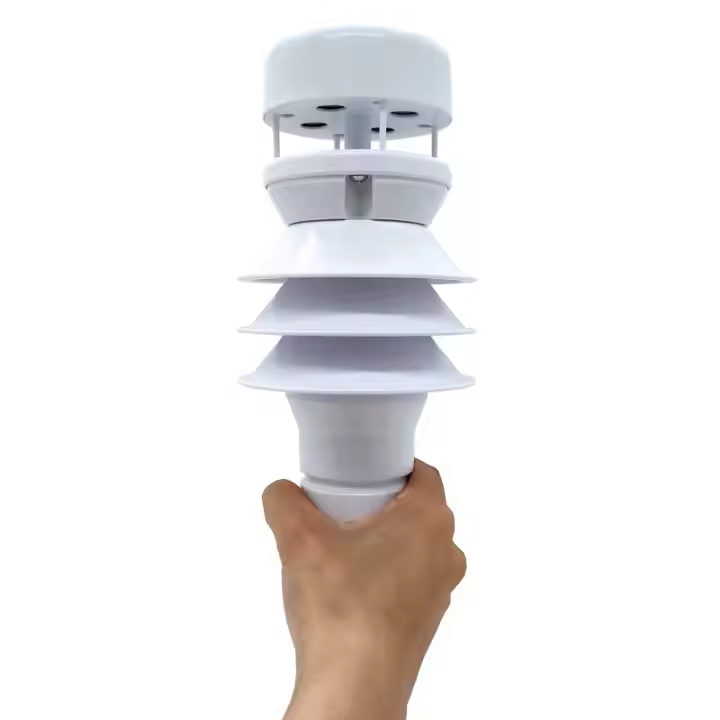வானிலை கண்காணிப்பு மற்றும் ஆராய்ச்சிக்கான ஒரு முக்கிய வசதியாக, வானிலையைப் புரிந்துகொள்வதிலும் முன்னறிவிப்பதிலும், காலநிலை மாற்றத்தைப் படிப்பதிலும், விவசாயத்தைப் பாதுகாப்பதிலும், பொருளாதார வளர்ச்சியை ஊக்குவிப்பதிலும் வானிலை நிலையங்கள் முக்கிய பங்கு வகிக்கின்றன. இந்த ஆய்வறிக்கை வானிலை நிலையத்தின் அடிப்படை செயல்பாடு, அமைப்பு, செயல்பாட்டு முறை மற்றும் நடைமுறையில் அதன் பயன்பாடு மற்றும் முக்கியத்துவம் பற்றி விவாதிக்கும்.
1. வானிலை நிலையங்களின் அடிப்படை செயல்பாடுகள்
வானிலை நிலையத்தின் முக்கிய செயல்பாடு, வானிலை தொடர்பான தரவுகளைச் சேகரித்தல், பதிவு செய்தல் மற்றும் பகுப்பாய்வு செய்தல் ஆகும். இந்தத் தரவு பின்வருவனவற்றை உள்ளடக்கியது, ஆனால் இவை மட்டும் அல்ல:
வெப்பநிலை: காற்று மற்றும் மேற்பரப்பு வெப்பநிலையில் ஏற்படும் மாற்றங்களைப் பதிவு செய்கிறது.
ஈரப்பதம்: காற்றில் உள்ள நீராவியின் அளவை அளவிடுகிறது மற்றும் வானிலை மாற்றங்களை பாதிக்கிறது.
காற்றழுத்தமானி அழுத்தம்: வானிலை அமைப்புகளின் இயக்கத்தை கணிக்க உதவும் வகையில் வளிமண்டல அழுத்தத்தில் ஏற்படும் மாற்றங்களைக் கண்காணிக்கிறது.
மழைப்பொழிவு: நீர்வள மேலாண்மை மற்றும் விவசாய நீர்ப்பாசனத்திற்கு மழைப்பொழிவின் அளவு மற்றும் தீவிரத்தை பதிவு செய்வது முக்கியம்.
காற்றின் வேகம் மற்றும் திசை: காற்றின் விளைவுகளை பகுப்பாய்வு செய்ய, குறிப்பாக சூறாவளி மற்றும் புயல்களின் முன்னறிவிப்பில், வானிலை நிலையங்கள் இந்தத் தரவை அனிமோமீட்டர்கள் மற்றும் காற்று வேன்கள் மூலம் சேகரிக்கின்றன.
2. வானிலை நிலையங்களின் அமைப்பு
விரிவான வானிலை தரவு சேகரிப்பை அடைய ஒரு வானிலை நிலையம் பொதுவாக பின்வரும் கூறுகளைக் கொண்டுள்ளது:
உணரிகள்: வெப்பநிலை உணரிகள், ஈரப்பதம் ஆய்வுகள், மழைப்பொழிவு மீட்டர்கள் போன்ற பல்வேறு வானிலை கூறுகளை அளவிடப் பயன்படும் சாதனங்கள்.
ரெக்கார்டர்: சென்சார் சேகரிக்கும் தகவல்களைப் பதிவு செய்யும் தரவு சேமிப்பு சாதனம்.
தகவல் தொடர்பு அமைப்பு: சேகரிக்கப்பட்ட தரவு, அடுத்தடுத்த பகுப்பாய்விற்காக உண்மையான நேரத்தில் வானிலை மையம் அல்லது தரவுத்தளத்திற்கு அனுப்பப்படுகிறது.
மின் சாதனங்கள்: வானிலை நிலையத்தின் நிலையான செயல்பாட்டை உறுதி செய்யும் மின்சாரம், பல நவீன வானிலை நிலையங்கள் சூரிய சக்தியைப் பயன்படுத்துகின்றன.
தரவு செயலாக்கம் மற்றும் பகுப்பாய்வு மென்பொருள்: வானிலை முன்னறிவிப்புகள் மற்றும் காலநிலை அறிக்கைகளை உருவாக்க தரவை பகுப்பாய்வு செய்து காட்சிப்படுத்த கணினி மென்பொருளைப் பயன்படுத்தவும்.
3. வானிலை நிலையங்களின் செயல்பாட்டு முறை
வானிலை நிலையங்கள் தானியங்கி வானிலை நிலையங்கள் மற்றும் செயற்கை வானிலை நிலையங்களாக பிரிக்கப்பட்டுள்ளன:
தானியங்கி வானிலை நிலையம்: இந்த வகை வானிலை நிலையம் பொதுவாக கணினிகள் மற்றும் சென்சார்களைக் கொண்டது, இது 24 மணி நேரமும் தரவைச் சேகரித்து நிகழ்நேரத்தில் தரவைப் பதிவேற்ற முடியும். இந்த வகையான வானிலை நிலையம் அதன் உயர் செயல்திறன் மற்றும் துல்லியம் காரணமாக அறிவியல் ஆராய்ச்சி மற்றும் வானிலை முன்னறிவிப்பில் பரவலாகப் பயன்படுத்தப்படுகிறது.
செயற்கை வானிலை நிலையங்கள்: இத்தகைய வானிலை நிலையங்கள் தினசரி கண்காணிப்பு மற்றும் பதிவுகளுக்கு வானிலை ஆய்வாளர்களை நம்பியுள்ளன. தரவுகளின் துல்லியம் மற்றும் நம்பகத்தன்மை அதிகமாக இருந்தாலும், வானிலை மற்றும் கையேடு செயல்பாட்டால் பாதிக்கப்படும், சில வரம்புகள் இருக்கும்.
கடுமையான தரப்படுத்தப்பட்ட செயல்முறைக்குப் பிறகு, வானிலை நிலையத்தின் தரவுகள் முதற்கட்டமாக சுத்தம் செய்யப்பட்டு சரிசெய்யப்படுவதோடு மட்டுமல்லாமல், வானிலை தகவல்களின் துல்லியம் மற்றும் நம்பகத்தன்மையை உறுதி செய்வதற்காக வானிலை துறையால் தணிக்கை செய்யப்பட வேண்டும்.
4. வானிலை நிலையங்களின் நடைமுறை பயன்பாடு
வானிலை நிலையங்கள் பல்வேறு துறைகளில் முக்கியமான பயன்பாடுகளைக் கொண்டுள்ளன, அவற்றுள்:
வானிலை முன்னறிவிப்பு: வானிலை நிலையங்களால் வழங்கப்படும் தரவுகளைக் கொண்டு, வானிலை ஆய்வாளர்கள் வானிலை போக்குகளை பகுப்பாய்வு செய்து, பொதுமக்கள் மற்றும் தொழில்கள் முன்கூட்டியே தயாராக உதவும் வகையில் துல்லியமான வானிலை முன்னறிவிப்புகளை உருவாக்க முடியும்.
விவசாய மேலாண்மை: விவசாயிகள் வானிலை நிலையங்களால் வழங்கப்படும் வானிலை தரவுகளின்படி நடவுத் திட்டங்களை சரிசெய்யலாம், நீர்ப்பாசனம் மற்றும் உரமிடுதலை பகுத்தறிவுடன் ஏற்பாடு செய்யலாம் மற்றும் விவசாய உற்பத்தி மற்றும் அறுவடையின் நிலைத்தன்மையை உறுதி செய்யலாம்.
காலநிலை ஆராய்ச்சி: நீண்டகால தரவுகளைச் சேகரிப்பதில், வானிலை நிலையங்கள் காலநிலை மாற்றத்தைப் பற்றி ஆய்வு செய்யவும், கொள்கை உருவாக்கம் மற்றும் சுற்றுச்சூழல் பாதுகாப்பிற்கான அறிவியல் அடிப்படையை வழங்கவும் உதவுகின்றன.
பேரிடர் முன்னெச்சரிக்கை: இயற்கை பேரிடர்கள் ஏற்படுவதற்கு முன்பு, வானிலை நிலையங்கள் புயல், கனமழை, தீவிர வெப்பநிலை போன்ற வானிலை முன்னெச்சரிக்கைகளை சரியான நேரத்தில் வழங்க முடியும், இதனால் அரசாங்கங்கள், நிறுவனங்கள் மற்றும் குடியிருப்பாளர்கள் பணியாளர்கள் மற்றும் சொத்து இழப்புகளைக் குறைக்க முன்கூட்டியே பாதுகாப்பு நடவடிக்கைகளை எடுக்க முடியும்.
5. உண்மையான வழக்குகள்
2019 ஆம் ஆண்டில் டைபூன் "லிங்லிங்" புயல் குறித்த முன் எச்சரிக்கை வழக்கு
2019 ஆம் ஆண்டில், லிங்லிங் என்ற சூறாவளி கிழக்கு சீனக் கடலில் கரையைக் கடந்தது, மேலும் புயல் வருவதற்கு முன்பு வானிலை நிலையங்கள் செய்த பல அவதானிப்புகள் காரணமாக முன்கூட்டியே ஒரு வலுவான வானிலை எச்சரிக்கை விடுக்கப்பட்டது. இந்த ஆரம்ப எச்சரிக்கைகள் கடலோரப் பகுதிகளில் வசிப்பவர்கள் முன்கூட்டியே தயாராக இருக்க உதவுகின்றன, இதனால் சூறாவளியால் ஏற்படும் உயிரிழப்புகள் மற்றும் சொத்து இழப்புகள் குறைகின்றன. வானிலை நிலையத்தின் நிகழ்நேர தரவு கண்காணிப்பு அமைப்பு, காற்றின் வேகம், அழுத்தம் மற்றும் பிற தரவுகளின் பகுப்பாய்வு மூலம் "லிங் லிங்" இன் தீவிரம் மற்றும் நகரும் பாதையை முன்னறிவித்தது, உள்ளூர் அரசாங்கத்தின் அவசரகால பதிலுக்கு ஒரு அறிவியல் அடிப்படையை வழங்குகிறது.
கிராமப்புற சீனாவில் வானிலை நிலையங்களின் விவசாய பயன்பாடு
சீனாவின் பல தொலைதூர கிராமப்புறங்களில், வானிலை துறைகள் பண்ணை வானிலை நிலையங்களை அமைத்துள்ளன. மண்ணின் ஈரப்பதம், வெப்பநிலை, மழைப்பொழிவு மற்றும் பிற தரவுகளைக் கண்காணிப்பதன் மூலம், விவசாயிகள் நடவு மற்றும் அறுவடை நேரத்தை ஒழுங்கமைக்க உதவும் வகையில் இந்த வானிலை நிலையங்கள் இலக்கு வானிலை முன்னறிவிப்புகளை உருவாக்கியுள்ளன. உதாரணமாக, ஒரு பிராந்தியத்தில், மழைப்பொழிவுத் தரவை சரியான நேரத்தில் அணுகுவது விவசாயிகள் தொடர்ச்சியான வறட்சிக்கு சிறப்பாக பதிலளிக்கவும், பயிர் வளர்ச்சியை உறுதி செய்யவும், உணவு உற்பத்தியை அதிகரிக்கவும் உதவியது.
காலநிலை மாற்ற ஆய்வுகளில் நீண்ட கால தொடர் தரவு
உலகெங்கிலும் உள்ள வானிலை நிலையங்களில் பல வருட வானிலை தரவுகள் சேகரிக்கப்பட்டு, காலநிலை மாற்ற கண்காணிப்புக்கு உறுதியான அடிப்படையை வழங்குகின்றன. உதாரணமாக, அமெரிக்காவில் உள்ள தேசிய காலநிலை தரவு மையம் (NCDC), காலநிலை மாற்றத்தின் போக்குகளை பகுப்பாய்வு செய்து கணிக்க நூற்றுக்கணக்கான வானிலை நிலையங்களிலிருந்து நீண்டகால தரவுகளை நம்பியுள்ளது. கடந்த சில தசாப்தங்களாக, அமெரிக்காவில் சராசரி வெப்பநிலை படிப்படியாக அதிகரித்து வருவதாகவும், இது சுற்றுச்சூழல் அமைப்புகளில் ஏற்படும் மாற்றங்களையும் இயற்கை பேரழிவுகளின் அதிர்வெண்ணையும் பாதித்துள்ளதாகவும் அவர்கள் கண்டறிந்தனர். காலநிலை மாற்றம் மற்றும் அது ஏற்படுத்தும் சவால்களை நிவர்த்தி செய்வதற்கான உத்திகளை வகுக்க கொள்கை வகுப்பாளர்களுக்கு இந்த ஆய்வுகள் ஒரு அறிவியல் அடிப்படையை வழங்குகின்றன.
6. வளர்ச்சியின் எதிர்கால திசை
தொழில்நுட்பம் உருவாகும்போது வானிலை நிலையங்களும் உருவாகி வருகின்றன. எதிர்காலத்தில் வானிலை நிலையங்கள் மிகவும் புத்திசாலித்தனமாகவும், வலையமைப்புடனும், ஒருங்கிணைந்ததாகவும் இருக்கும்:
நுண்ணறிவு வானிலை நிலையம்: தரவு செயலாக்க திறன் மற்றும் துல்லியத்தை மேம்படுத்த செயற்கை நுண்ணறிவு மற்றும் பெரிய தரவு பகுப்பாய்வு தொழில்நுட்பத்தைப் பயன்படுத்தவும்.
வலையமைப்பு: நிகழ்நேரத் தரவைப் பகிர்ந்து கொள்ளவும் ஒட்டுமொத்த கண்காணிப்பு திறனை மேம்படுத்தவும் பல வானிலை நிலையங்களுக்கு இடையே ஒரு வலையமைப்பு உருவாக்கப்படுகிறது.
வான்வழி கண்காணிப்பு: வானிலை கண்காணிப்பின் நோக்கத்தையும் ஆழத்தையும் விரிவுபடுத்த ட்ரோன்கள் மற்றும் செயற்கைக்கோள்கள் போன்ற புதிய தொழில்நுட்பங்களை இணைத்தல்.
முடிவுரை
வானிலை கண்காணிப்பு மற்றும் ஆராய்ச்சிக்கான ஒரு முக்கியமான வசதியாக, வானிலை நிலையங்கள் வானிலை முன்னறிவிப்புக்கான அடிப்படை தரவு ஆதரவை வழங்குவதோடு மட்டுமல்லாமல், காலநிலை மாற்ற ஆராய்ச்சி, விவசாய வானிலை சேவை மற்றும் பேரிடர் முன்னெச்சரிக்கை போன்ற பல்வேறு துறைகளிலும் இன்றியமையாத பங்கை வகிக்கின்றன. தொடர்ச்சியான தொழில்நுட்ப முன்னேற்றம் மற்றும் தரவு புதுப்பிப்பு மூலம், வானிலை நிலையங்கள் மனித வாழ்க்கை மற்றும் பொருளாதார வளர்ச்சிக்கு மிகவும் துல்லியமான மற்றும் சரியான நேரத்தில் வானிலை சேவைகளை வழங்கும், மேலும் காலநிலை மாற்றத்தின் சவாலை எதிர்கொள்ள பங்களிக்கும்.
இடுகை நேரம்: ஏப்ரல்-15-2025


